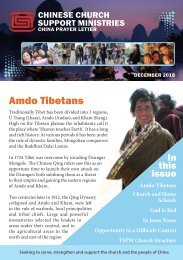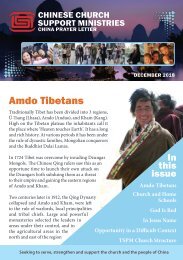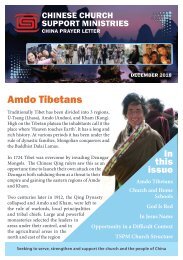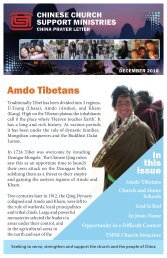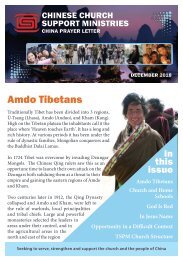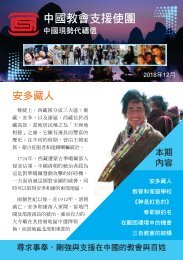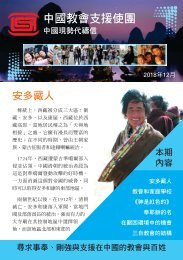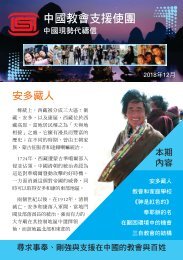PU_December2018_USA_web
You also want an ePaper? Increase the reach of your titles
YUMPU automatically turns print PDFs into web optimized ePapers that Google loves.
egion the Hui Muslims held power.<br />
Not all was peaceful.<br />
Bloody clashes took<br />
place between the<br />
Tibetans and Hui<br />
Muslim warlords.<br />
These warlords<br />
later sided with<br />
the Kuomintang in<br />
1928.<br />
By 1952 the Communist Party of<br />
China forces had overpowered<br />
both the Kuomintang and the local<br />
Tibetans and had won control of<br />
the region. A revolt erupted among<br />
the fiercely independent Tibetans,<br />
beginning in Amdo in 1959, and led<br />
to tremendous loss of Tibetan lives<br />
and the bombarding of most of the<br />
monasteries. It was followed by a<br />
devastating famine.<br />
Today, Amdo has been largely<br />
incorporated into the Qinghai Province<br />
with pockets in the Gansu and Sichuan<br />
Provinces. An Amdo county remains<br />
in the Tibet Autonomous Region.<br />
What makes Amdo Tibetans distinct<br />
from other Tibetans is the language<br />
they speak, known as Amdolese. This<br />
is one of the four main spoken Tibetic<br />
languages, the other three being<br />
Central Tibetan, Khams Tibetan,<br />
and Ladakhi. Amdolese language is<br />
not a tonal language like Central and<br />
Khams Tibetan. In addition, there<br />
are many dialects within<br />
Amdolese due<br />
to the<br />
2<br />
geographical isolation of the many<br />
groups. However, all<br />
Tibetans use the same<br />
written script and<br />
can communicate<br />
by swapping notes.<br />
Across the different<br />
groups there around<br />
1.4 million Amdo<br />
speakers.<br />
Mostly living outside the cities, the<br />
Amdo Tibetans are generally seminomadic<br />
herders and farmers. They<br />
are devoted followers of Tibetan<br />
Buddhism but mix it with the Bon<br />
religion and its multitude of divinities,<br />
rites and rituals. Dance plays a large<br />
part in their celebrations.<br />
Amdo Tibetans have been described<br />
as intelligent people who require<br />
reasoning rather than instruction.<br />
According to the Joshua Project several<br />
mission agencies worked in the Amdo<br />
area prior to 1949 and at least five<br />
small churches consisting of Amdo<br />
Tibetans remain today. Even so, more<br />
than 95% of the Amdo Tibetans have<br />
never heard the gospel message. When<br />
they do come to believe, standing for<br />
Christ will take courage as they are<br />
likely to be disowned by their family.<br />
The handful of believers working with<br />
the Amdo Tibetans are precious to<br />
the Kingdom as many people baulk at<br />
living in the region due to the food,<br />
the remote areas and the arid and cold<br />
climate. In addition, during periods<br />
of conflict, sensitive regions have been<br />
closed off to visitors.



